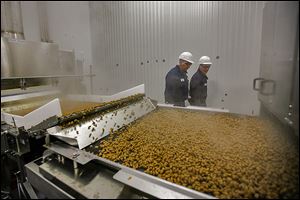
Pet food moves up to ‘fresh’ and ‘natural’
Owners ready to spend for furry friends
10/27/2013
The conveyor belt carries dog food at Freshpet’s kitchen in Bethlehem, Pa. The upstart pet food maker uses fresh meat, poultry, and vegetables to put out a pricey, preservative-free product that requires refrigeration. Sales exceed $100 million.
BETHLEHEM, Pa. — Organic kibble? All-natural chow? Fido and Fluffy don’t know it, but their owners want them to eat better — and they are forking over big bucks to make it happen.
Marketed as a healthier, more nutritious alternative, some premium dog and cat cuisine has gone the Whole Foods route.
Nowhere is that more evident than in Freshpet’s new $25 million factory in eastern Pennsylvania. There thousands of pounds of fresh meat and poultry are pasteurized, mixed with vegetables, chilled, packaged, and sent to branded, refrigerated display cases in more than 10,000 U.S. stores.
The 7-year-old company, founded by former Purina executives, is trying to establish a category in an industry long dominated by kibbles and cans: fresh, preservative-free food that requires refrigeration.
With sales exceeding $100 million, executives say they are on their way. “People are trying to eat healthier, less processed, simpler foods, and I think they are applying that logic when they’re making pet food decisions,” said Scott Morris, Freshpet’s president and co-founder.
Major manufacturers such as Nestle Purina and Del Monte Foods are capitalizing on consumers’ willingness to spend more on food they perceive to be better for their furry friends. Even through the Great Recession, premium dog and cat food — the latest of which is advertised as “natural” and “organic” — has been claiming an ever-bigger share of the market. Sales of the more expensive brands jumped 68 percent from 2002 to 2012, compared with 19 percent for midpriced brands, and just 8 percent for economy brands, according to Euromonitor International.
Marketing experts say manufacturers are tapping into a number of powerful trends and emotions: Americans’ interest in healthy eating, the rising popularity of organic food, the tendency to humanize pets. “People think of their pets not as pets, but as members of their family, and they want to treat the members of their family with the same respect as they treat themselves,” said Molly Maier, a market analyst at Mintel Group Ltd.
Nestle, the No. 1 pet food maker, has reported solid growth in its high-end Beyond line, “made with natural ingredients.”
The jury is still out on whether food marketed as “fresh,” “organic” or “natural” helps pets lead longer or healthier lives. Theoretically, it’s hard to argue with the idea that minimally processed and preservative-free food would be better for dogs and cats, said Amy Farcas, a University of Pennsylvania veterinary clinical nutritionist. But she said the research to prove it is lacking. She routinely advises her clients as long as their dog is an appropriate weight, healthy, and energetic, it probably does not need a diet change.